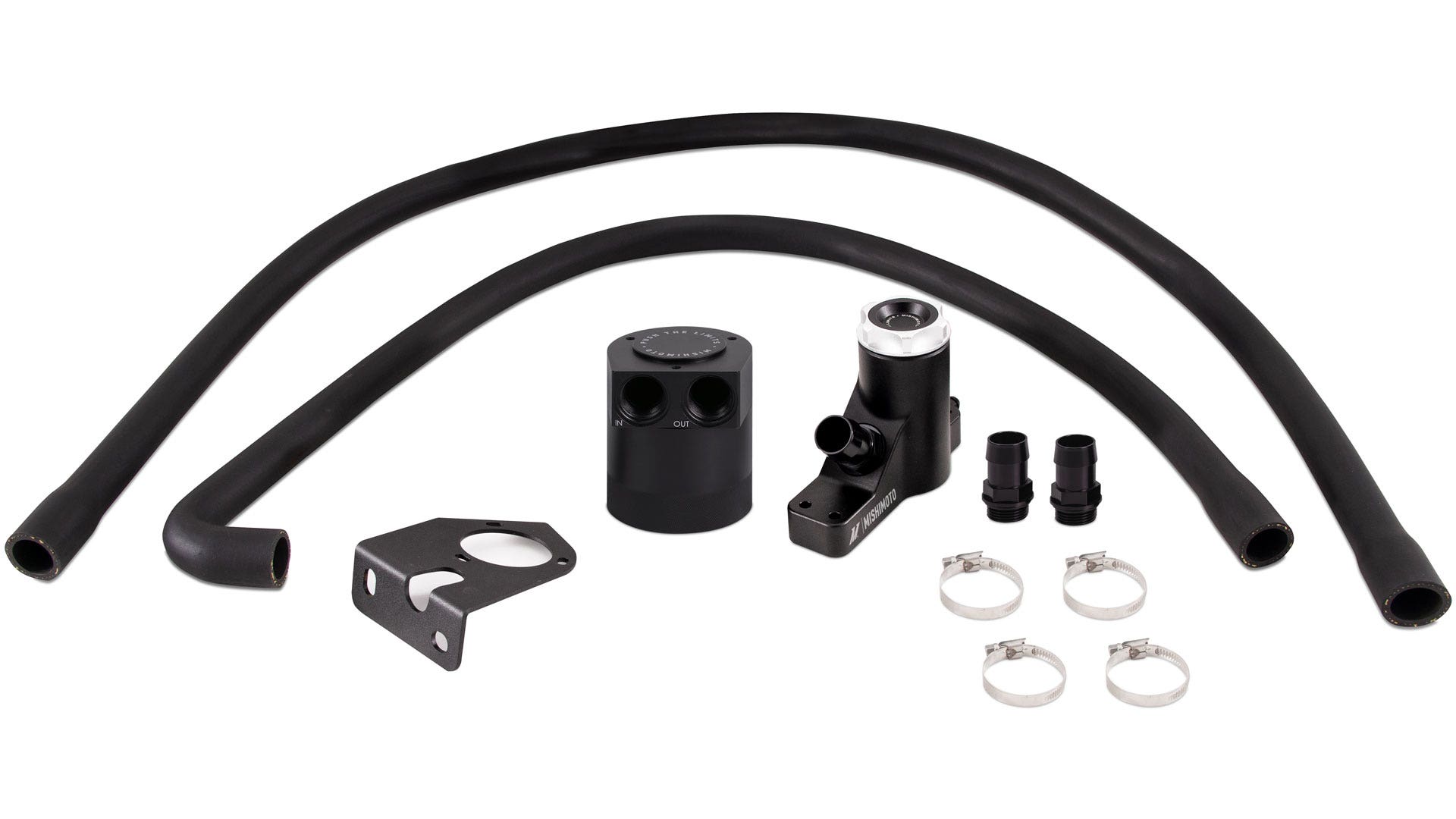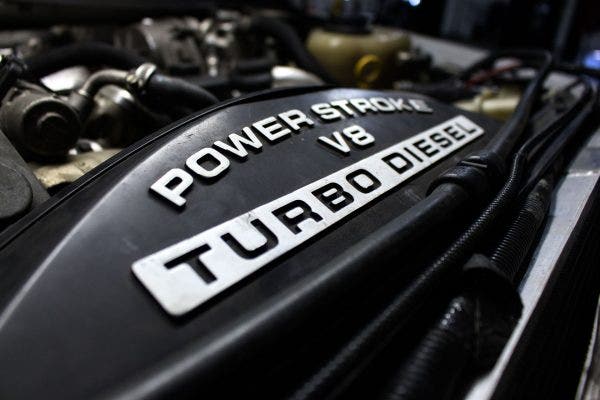
In Good Health - Baffled Oil Catch Can Kit R&D: Start to Finish
If you're like most 6.4L Powerstroke owners, your truck is your livelihood. It gets you around, carries your tools, tows your equipment, and anything else you need to get the job done. You rely on your 6.4L every day and want to keep it healthy, but your 6.4L isn't as diligent about its own well-being.
Like all modern internal combustion engines, the 6.4L Powerstroke generates blow-by. This blow-by is made of carbon, oil, fuel, and water vapors that leak past the piston rings during combustion. Blow-by can be extremely detrimental to the bottom end of an engine if left unvented. The pressure from blow-by buildup can push out seals and reduce engine power. The corrosive nature of blow-by can also damage engine bearings and reduce oil life. To get the blow-by out of the bottom end, modern engines (including the 6.4L) utilize a crankcase ventilation (CCV) system.

CCV system designs vary by manufacturer and engine, but most include two components: a connection to the crankcase and a connection to a vacuum source. The crankcase connection serves to give the blow-by a path out of the crankcase. The vacuum source serves two purposes. First, the vacuum helps pull the blow-by out of the crankcase so that it doesn't build up on bottom-end engine components like the crankshaft or bearings. The second function of the vacuum source is to draw the blow-by back into the intake to be burned off.
If you're thinking, "Wait, if blow-by is so bad, why is my engine burning it off?" you're not alone. Consuming blow-by is not good for your 6.4L. It builds up on the back of intake valves and EGR systems, and in high enough volumes, it can cause knock. But environmental concerns mean blow-by needs somewhere to go other than the ground, and to avoid adding more maintenance for owners, most manufacturers decide to burn it off through combustion. The 6.4L CCV system takes this concept one step farther, however.

To help prevent some of the issues associated with burning blow-by, many CCV systems attempt to remove the oil and fuel vapors from the blow-by gasses. In the case of the 6.4L Powerstroke, the engineers at Ford devised a clever solution. Built into the oil fill neck is a cyclonic separator. This separator spins the blow-by gasses around a tapered cone. As the blow-by spins, the oil, fuel, and water vapors are pushed against the walls of the separator by centrifugal force. The vapor condenses on the walls of the separator and fall to the bottom, where a drain line returns them to the engine oil.

This process keeps some blow-by out of the intake and charge air cooling system, but it isn't perfect. Some vapor still sneaks back into the turbo inlet. It also presents another issue: oil dilution. A significant portion of blow-by is fuel vapor. This fuel vapor drops out of the blow-by gasses with the oil vapor and is dumped into the 6.4L's engine oil. But fuel doesn't have the same lubricating properties as oil and too much fuel in the pan can make your engine oil useless. Even if there was no fuel vapor in the blow-by, the oil vapor that's returned to the pan has been through the combustion cycle and is contaminated with water and carbon, further reducing its ability to lubricate critical engine parts.
So, what's the solution if you can't vent the blow-by to the atmosphere, and you can't recycle it through the engine? The best way to keep your 6.4L running healthy and blow-by free is to capture the blow-by as soon as it exits the crankcase and contain it to be recycled with the rest of your engine oil. That's exactly what Mishimoto's 2008-2010 Ford 6.4L Powerstroke Baffled Oil Catch Can Kit does.

Development of our 6.4L catch can kit began with our engineer, Jason, analyzing the stock oil fill neck/oil separator, then designing and 3D printing a replacement. This new fill neck is designed to kill two birds with one stone: intercept the blow-by and direct it to our catch can, and replace the failure-prone stock ratcheting oil cap. The new oil fill neck reuses the stock O-ring and retains the oil drain hose on the front of the mount to allow excess crankcase pressure to be vented under heavy loads. A large 22mm port and line will carry the blow-by to our catch can.

To mount the catch can, we left the cramped 6.4L engine bay and headed down to the frame rail. Just behind the passenger front wheel, we found the perfect location for our catch can to live. A bolt holding the ground strap and an open stud just behind the cab mount made for a sturdy mount. Our engineer used the waterjet to cut out a bracket, then bent it into shape and mounted our can. From there, all that was left to do in the design phase was run a return line to the turbo inlet pipe for a vacuum source.

With our catch can kit mocked up, we needed to test it to see if it would catch any blow-by. But 3D printed parts don't hold up well in hot engine bays and they're not air-tight enough to contain blow-by. So, Jason headed over to our fabrication area to build a functional prototype. A radiator fill neck combined with an aluminum rectangle tube, two hose barbs, and a block of aluminum cut on our waterjet to fit the 6.4L's head would fit the bill. It wasn't pretty, but it would serve as our proof of concept and tell us if our kit would work. We bolted on the catch can and prototype fill neck, ran the lines to either side of the system and sent the truck out for a 1,000-mile road test.

A few weeks later we eagerly drove our 6.4L into the shop to check the results. The location of the catch can made checking the contents a breeze and we had our results in short order. The catch can had caught about 25 ml of fuel-laden oil that would have otherwise gone into the intake or the oil pan. Our road test was a success, now we just had to make it look as good as it functioned. We used Jason's original design to kick off a production sample.

After a short wait, our production sample arrived. We carefully unwrapped the parts and revealed a CNC-machined aluminum fill neck, 3mm-thick steel bracket, and lines designed to tie it all together seamlessly. To top it all off, Jason included stainless steel catch can mounting bolts to withstand the harsh environment under the truck. We finished unpacking the sample and went to work installing it on the truck. About an hour later, our 2008-2010 Ford 6.4L Powerstroke catch can kit was installed.

As we wrap up the first round of production, we're starting a limited time pre-sale at a deep discount. Head over to our website to purchase this catch can kit and keep your 6.4L Powerstoke in good health.




